Christ’s Descent Into Hades
1. Hell and Hades in Biblical Literature
The terms “Hell” and “Hades” are often used interchangeably by English translators.
This unfortunate tendency is a product of Western influence. While Latin has both the
words infernum and gehenna, the former served as the normative term in the West to
refer to the lower regions, the abyss, and hell interchangeably, without differentiation.
Yet, the Greek terms Hell (gehenna) and Hades (hadēs) are used with clear delineation in
Jewish tradition, in the NT, and in the Eastern Church fathers.
In Josephus’ Dissertation on Hades, he lays out the common Jewish understanding of the doctrine in literal terms. Hades, Josephus tells us, is a subterranean region into which
the souls of the dead, righteous and wicked, enter. The righteous and wicked are
separated by angels, who tend to these souls as they all await judgment. The condition
of the righteous is pleasant, while that of the wicked is unpleasant. Josephus also
mentions a lake of fire into which the wicked are cast after the final judgement, but he
is clear that no one is yet in this lake, since the judgment has not taken place1.
The NT uses both gehenna and hadēs, but the terms are not interchangeable. Their uses instead reflect the Jewish lore explained by Josephus. In the parable of the Rich Man and Lazarus (Luke 16:19-31), for example, Jesus speaks about hadēs (16:23), not gehenna. The Rich Man lifts up his eyes in Hades and sees Lazarus on Abraham’s bosoms (16:24) — a picture of Lazarus reclining on his chest (cf. Jn 13:23). The Rich Man speaks of being in torment, and of being in a flame, and Abraham mentions a chasm between himself and the Rich Man. Although the parable does not state explicitly that Abraham and Lazarus are in Hades with the Rich Man, this is the implication of Jewish lore reported by Josephus, since this region is the post-mortem dwelling of both the righteous and the wicked. All three are in Hades. There, the Rich Man suffers, while Lazarus is comforted (by Abraham).
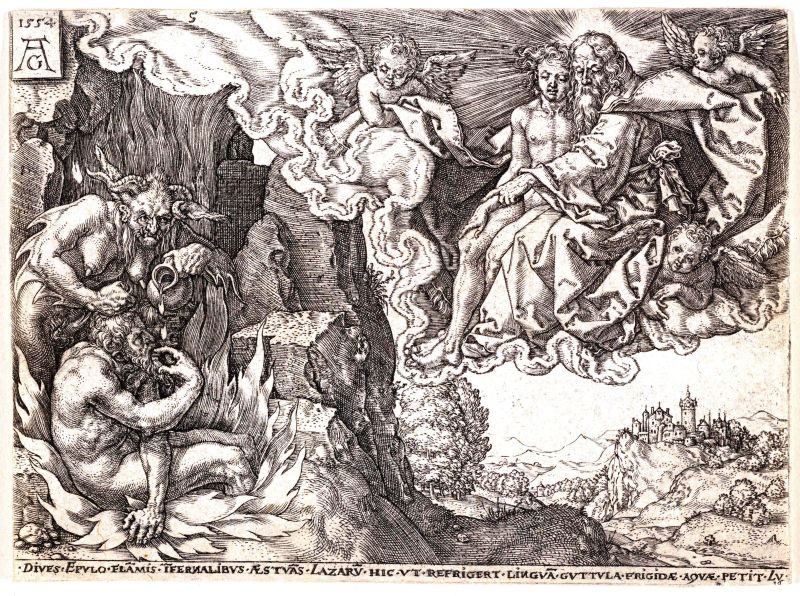
Peter’s Pentecost homily also mentions Hades and confirms the above reading, namely,
that it is the holding place for the souls of both the righteous and the wicked. He quotes Psalm 16:8-11 (LXX), which speaks about God not abandoning his Holy One to Hades (not Hell), nor letting him see corruption (Acts 2:27). Peter interprets this Psalm as a prophecy about Christ, since David’s body remains in the grave (subject to
corruption), and Peter’s hearers thus presume (as reported by Josephus) that David’s soul is in Hades. But, Peter continues, Christ’s soul was not abandoned to Hades nor his body to corruption. For God raised him from the dead (2:31).
The declaration that Christ was not abandoned to Hades is in keeping with the NT
theme that Christ was victorious over death and Hades. Christ prophesied that the gates of Hades (not Hell) would not prevail against him (Matt 16:18). Peter tells us that in Christ’s descent into Hades, he preached to those held in this “prison” (phylakē) (1 Pet 3:19) in order that they might “live according to God in spirit” (1 Pet 4:6). And
Christ’s victory over Hades is, of course, manifest in his Resurrection and proclaimed in both Peter’s Pentecost homily and Christ’s declaration to John that he holds the keys to death and Hades (not Hell) (Rev 1:18). These various passages converge to form the picture that death and Hades is a prison in which mankind was held prior to the advent of Christ; into this prison Christ entered and preached in order to liberate mankind; the gates of this prison did not prevail against him; and because of his victory over death, Christ now holds the keys to death and Hades.
The lake of fire from Jewish lore also appears in the NT, along with the sentiment that the lake is empty until the final judgment. In the book of Revelation, Hades (not Hell) gives up its dead in the universal resurrection for judgment (Rev 20:11-13). Only after the judgment is anyone — or thing — cast into the lake of fire. First death and Hades are cast in (Rev 20:14) and then the wicked (Rev 21:8).
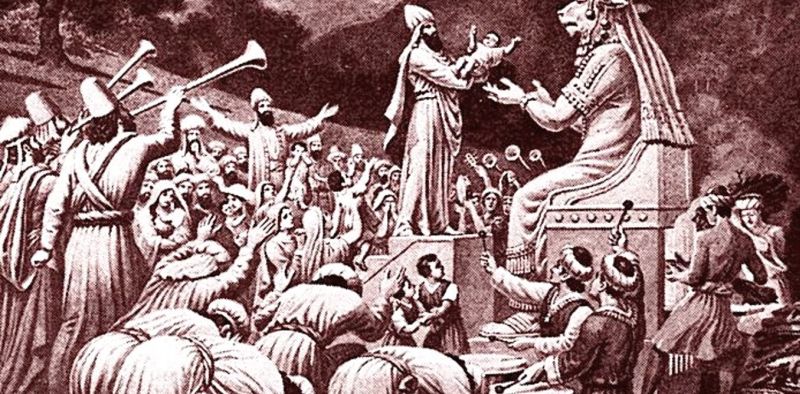
The biblical use of “Hell” (gehenna) evidently refers to the lake of fire —
though the word originally referred to
the valley outside of Jerusalem where
children were sacrificed to Moloch (cf.
Lev 18:21). The numerous NT
mentions of “the hell of fire” or “the
hell” or “hell” use the language, echoed
in Revelation, of being cast or thrown
into Hell (Matt 5:30 and Luke 12:5). And Christ explicitly associates gehenna with final
judgment (Matt 23:33). More importantly, however, these numerous references speak
of being thrown bodily into Hell, indicating a post-resurrection fate. Christ often draws
the contrast between those who can harm the body but not the soul and God who can
cast both body and soul into Hell; Christ recommends gauging out one eye to avoid
being thrown into Hell with two; or cutting off one hand, as opposed to being thrown
with two into Hell (Matt 5:30; 5:31; 10:29; 18:9; Mark 9:43, 45, and 47). In other
words, disembodied souls are not cast into Hell after death; souls and bodies are cast
into Hell after the resurrection and judgment. Presumably, this is the eternal fire
prepared for the Devil and his angels (Matt 25:41).
Biblical references to the “second death” refer specifically to the lake of fire (Rev 20:14; 21:8). The experience of the second death in the NT is identified with being cast into
this lake (Rev 21:8), an event that occurs only after the universal resurrection and the
final judgment (Rev 20:11-13). As mentioned above, such casting is first done to death
and Hades (Rev 20:14) and then to the wicked (Rev 21:8).
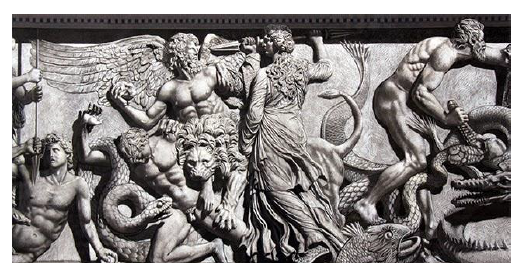
Finally, in the NT we also find
mention of Tartarus — the dark
abyss into which Zeus cast
Chronos and the Titans in
Greek mythology. This phrase
appears in 2 Peter 2:4, referring
to the place into which God
casts the fallen angels. There,
these angels were held by “chains of gloom” (seirais zophou) — or just held in gloom,
since the word “chains” does not appear in all manuscripts. Presumably this is the abyss
that the demons mention when pleading with Christ to not cast them out of
demoniacs (Luke 8:31).
By way of summary, then, the NT teachings about Hell and Hades draw a distinction
between these. Hades is the realm of the dead into which the souls of both righteous and wicked enter when the soul departs the body. Man, being captive to death prior to the advent of Christ, was held in this prison. There, the souls of the wicked suffered, while the souls of the righteous were comforted. The Devil and his angels, by contrast, were cast into the abyss of Tartarus after their rebellion, where they were held in
(chains of) gloom. As for Christ’s descent, his soul entered Hades after his crucifixion.
He preached to souls held captive there. In his resurrection, he was victorious over Hades, and liberated humanity from this prison — its gates did not prevail against him, and he now holds the keys to death and Hades. Hell, by contrast, refers to a lake of eternal fire prepared for the Devil and his angels. Into this lake none are cast until after
the final judgment. At the resurrection, Hades is emptied of whatever souls remain within it and all are judged in the body. Following the judgment, death and Hades are cast into the lake of fire, which is the second death, and then the wicked too are cast bodily into the lake of fire, which is the second death.
2. Hell and Hades in the Eastern Church Fathers
In Eastern patristic literature, we find the very distinction between Hades and Hell that appears in the NT. The Eastern fathers refer to Gehenna as a place of future judgment2 characterized by fire. And to be cast into Gehenna after the final judgment is to experience the second death3.
Now, Alexandrian Judaism, with its allegorizing tendencies, rejected the literal
interpretation of Jewish lore reported by Josephus. Philo of Alexandria, for example,
suggests that Hades is a metaphor for the condition of the soul. Hence Philo, after
declaring that there is no subterranean region beneath our feet, says that Hades refers
to the condition of the wicked, who wander about in vice apart from God. This
condition is the true Hades, says Philo4.
The Eastern Church fathers, like the Alexandrian Jews, likewise interpret the biblical
images as allegorical pictures of deeper truths. Many read the eternal (or uncreated) fire
as God’s own love and presence5 — which is why this fire (a common picture of God 6) is
eternal. Yet, this fire has a double effect, “one that burns, and another that illumines”7.
The difference, Basil tells us, is not located in God but in the respective conditions of
the righteous and the wicked: “The evils in Hell do not have God as their cause, but we
cause them.” Just as the sun scorches bad soil while causing good soil to flourish, so the
presence of God is joy to the righteous but pain to the wicked8. Hence, how one
experiences the glory of God is based on the “quality of his disposition9”.
Whether the condition of the wicked described in the second death is permanent is a
matter of dispute amongst the Eastern fathers. The majority view is yes, but St. Isaac of
Syria sees even Gehenna as “belonging to mercy” and God’s “eternal goodness,” with
its end being purification10. Gregory of Nyssa, likewise, holds out hope that those who
suffer the condemnation of Gehenna might still be led ultimately into the final restoration of the Kingdom of Heaven11. Regardless, even those Eastern fathers who
oppose such views, believing Hell represents a final and irreversible state, do not locate
the permanence of damnation in God, but in the creature. Chrysostom, who certainly
believes Gehenna to be permanent12, locates this permanence in the creature’s refusal
to repent. In his exposition of the “unpardonable sin,” Chrysostom points out that
Christ does not say the sin is per se unpardonable but that it won’t be pardoned,
indicating that pardon is possible — as with all sins — but those who commit this sin
refuse to repent of it. Hence, as C. S. Lewis’ well-known phrase puts it, Hell is locked
from the inside. For God calls all to salvation, but he never deals forcibly or coercively
with anyone13.
Regarding Hades, the Eastern fathers have far more to say, precisely because of the
doctrine of Christ’s descent thereto. Like the NT, the Eastern fathers identify Hades as
the realm of the dead, equating it with Sheol of the Old Testament. As for who is in
Hades, they are clear that, because death came to all men through Adam, Hades held
both the righteous and the wicked, prior to the advent of Christ14. There, in Hades, all
sat in darkness. The wicked suffered, while the righteous were comforted as they waited
for Christ, the door to the Father15.
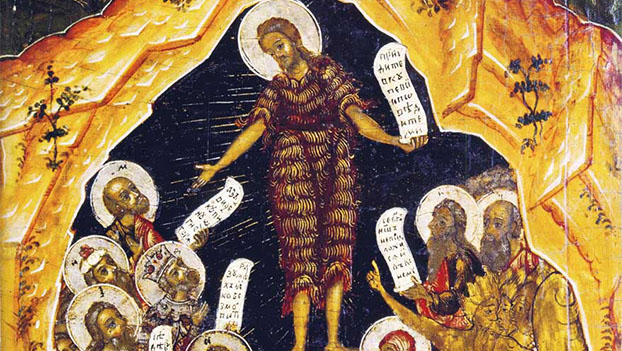
Several Eastern fathers suggest that the
preparation for Christ’s own descent began well
before the advent of Christ. Both Chrysostom
and Origen speak about the OT prophets
preaching to the dead about Christ’s future
coming16. And both Origen and Gregory of
Nazianzus teach that John the Baptist, who was
the forerunner of Christ on the earth, was also
his forerunner “under the earth,” preaching to
souls in Hades about the quickly Christ who was
soon to come17.
Now, regarding Christ’s descent into Hades, the Eastern fathers consistently treat it as salvific — as significant to the salvation of humanity as his Crucifixion or Resurrection.
By descending into Hades, Christ saves humanity from death and Hades18. The
underlying rationale is this. Christ’s descent destroys death because, being divine, he
bears in his person Eternal Life. Hence, when Christ enters Hades, Life enters the
realm of the dead19. Both Chrysostom and John of Damascus speak about the light of Christ destroying the darkness of Hades — the Sun of Righteousness filling it, his
deified soul, shining forth the uncreated light of God into its darkness20. So, just as
created light destroys darkness, so the divine light and life of Christ in Hades destroys
its darkness of death. For this reason, the Eastern fathers also speak about Christ
transforming Hades from dark and joyless into paradise. Chrysostom sees this in
Christ’s promise to the thief on the cross. Christ could promise the thief that he would
be in paradise today, even though they would both descend into Hades — Christ stating
plainly after his Resurrection that he did not yet ascend to his Father (Jn 20:17). The
paradise the thief was promised was in Hades, for there the light of Christ would shine,
making that place into paradise21.
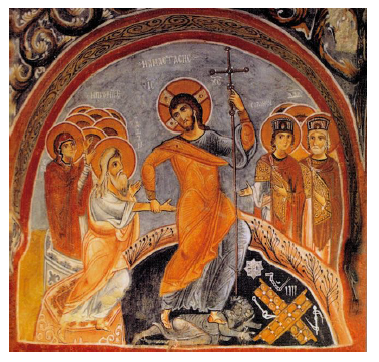
The undoing of death in Christ’s
descent also informs how the Eastern
fathers understand Christ to have
defeated the Devil, who holds the
power of death22. Gregory of Nyssa
famously describes the defeat of Satan
using a “fish hook” metaphor. The
Devil, catching glimpses of divine
light within Christ’s flesh, is enticed
to lay hold of him, like a fish drawn
to bait on a hook. Seeing the Son of
God veiled in mortal flesh23, Satan
cannot resist the prospect of killing
him. But what the Devil does not
realize is that, in delivering Christ to Hades, Christ will undo death, and thus
overthrow Satan’s power over humanity, bringing life to the dead24. In this way, Christ
binds the strong man (the Devil) and plunders his house (Hades)25.
This “plundering” is depicted by the Eastern fathers as Christ emptying the tombs of
Hades26 and breaking its gates, as he prophesied27. For the gates of Hades held
humanity within the prison (phylakē) of death28. In breaking these, Christ liberated all
those held there — that is, the whole human race. For the Eastern fathers are clear:
Christ descended in order to save all of humanity29. In this light, the phrase of Lewis —
that Hell is locked from the inside — is too strong. For it suggests that there is still a
door between humanity and God. According to the Eastern fathers, the gates of Hades
have been destroyed. The more appropriate picture is of a former prison in which all
the bars have been removed and destroyed. If any remain within the prison, it is not
because of a gate.
In addition to transforming Hades and plundering it, the Eastern fathers also speak
about Christ preaching to the souls there, drawing on 1 Peter 3:19. They speak about
Christ appearing to the dead in Hades, just as he appeared to the mortals upon the
earth30. And there, in Hades, Christ preached to them, righteous and wicked alike,
converting all who were willing to receive him31. Now, whether all did in fact receive
Christ is a question that most Eastern fathers pass over in silence. They confidently
affirm that the OT Saints received Christ, since it was him whom they anticipated and
awaited32, but the Eastern fathers make no dogmatic assertions about the wicked. The
wicked were liberated with the righteous; Christ preached to the wicked; he did so in
order to save them; and as many as received him were saved33. On this they agree. But
whether none, some, or all of the wicked did in fact receive Christ and exit Hades is a
matter that few Eastern fathers speculate about.
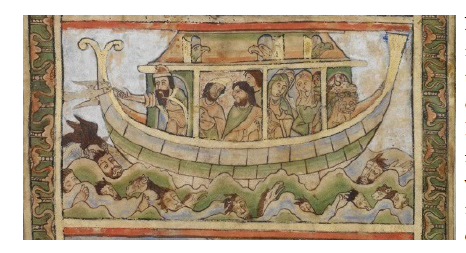
Maximus the Confessor illuminates the liberation of
the wicked in Hades in his
comments on 1 Peter 4:6.
He explains that those who
rebelled in the time of Noah
were judged in the flesh as
men (drowned and their
disembodied souls were cast
into Hades) so that they might live according to God in the spirit (at the preaching of
Christ). Maximus here echoes the Eastern patristic theme that death is a divine mercy,
which unmakes corrupted man, so that we might be remade incorrupt in the
resurrection from the dead34. So, in the same way, the wicked in the time of Noah were
unmade by their drowning, so that they might be made alive by the preaching of Christ
and remade incorrupt in the resurrection35. So it is for all the wicked held in Hades.
Yet, whether the wicked receive Christ and the life he offers or not, the fact remains
that Christ’s descent has transformed Hades, liberated all, and opened the way back to
the Father of Lights.
Though Hades is more often than not depicted as a place, which is a prison, or “Satan’s
house,” in which humanity is held captive, Eastern patristic literature — and
iconography — also depicts Hades as a sentient being that swallows up humanity,
holding dead men captive within its belly. Arguably, this sentient depiction of Hades is
taken from Revelation, where Hades “gives up” — an active verb (adōkan) — the dead
within it and is later thrown into the lake of fire, a picture more easily associated with a
being than a cave beneath the earth. But regardless of the source, this
anthropomorphic image of Hades also plays a role in the Eastern patristic teachings on
Christ’s victory. We see it is poetically employed in The Gospel of Nicodemus, written
sometime between the 3rd and 5th centuries. Therein, we find the following dialogue
between Satan and Hades:
Satan, the prince and chief of death, said to Hades: Make yourself ready to receive
Jesus, who boasts himself to be the Son of God, whereas he is a man that fears death….
Hades answered and said to Satan the prince: Who is he that is so mighty, if he is a
man that fears death? For all the mighty ones of the earth are held in subjection by my
power, even they whom you have brought me subdued by your power. If, then, you are
mighty, what manner of man is this Jesus who, though he fears death, resists your power? …
But Satan the prince of Tartarus said: Why do you doubt and fear to receive this Jesus
which is your adversary and mine? … Hades answered and said: You have told me that
it is he that has taken away dead men from me [e.g., Lazarus]…. Satan the prince of
death answered and said: It is the same Jesus. When Hades heard that he said to
him: I adjure you by thy strength and mine own that you bring him not to me.
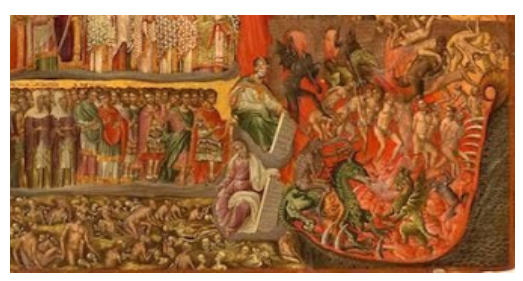
In Eastern Christian iconography, this
sentient Hades is depicted in what is
sometimes (inaccurately) called the “Hell
mouth” in the icon of the Final Judgment
icon. In the lower right corner of the icon
is the head of a large monster, from
which comes the dead for judgment. In
some (rare) icons of the Resurrection,
Christ is depicted as coming forth from
this same monstrous head, bringing with
him Adam, Eve, and others who have
died. And this same head appears in the
icon of Jonah. In keeping with Christ’s
own words that Jonah is a picture of his
future descent into “the belly of the
earth” (that is, into Hades) (Matt 12:40), Eastern Christian iconographers often depict
Jonah in the garb of Christ, coming forth from the fish that is depicted as Hades, the
same monstrous head we see displayed in the icon of the Final Judgment.
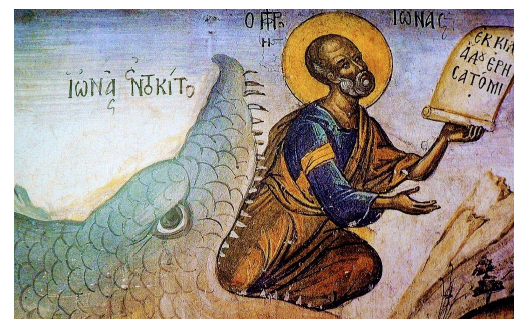
It is this monstrous Hades whom Chrysostom, in his famous Paschal homily, speaks of
as repeatedly “embittered” (pikrainō) — a term of sentiens — because it took into itself a
body but encountered God; it took into itself earth and encountered Heaven; it took
into itself the visible and encountered the invisible36. The picture is an inversion of a
living body taking into itself poison, which communicates to it death. In this case,
Hades, who is the embodiment of death, takes into itself Him who is Life, and this
Christ communicates life to all within it. The defeat of Hades that follows is the
Resurrection of Jesus37. This event of events is anthropomorphized as Hades vomiting
up Christ, since it cannot digest him who bears in his person Life itself38. In this defeat
of Hades, Christ thus demonstrates that death has no dominion over him39, as he steps
forth as the first fruits of the Resurrection from the dead, showing us the way of
resurrection40. And while Christ descended alone, he rose and ascended with many.41
Now, as with Hell, the imagery of Hades is read in an allegorical way by the Eastern
fathers, which is why they are untroubled by the idea that Hades might be depicted in
multiple ones — sometimes as a place and other times as a being. Macrina, when
speaking to her brother, Gregory of Nyssa, offers a reductio ad absurdum as to why Hades
cannot literally be “under the earth.” As she points out, the dwelling of spirits is the air,
and the earth is a sphere. Hence, the air under the earth is the same air above the earth.
So, when the soul leaves the body and enters “Hades,” its spatial location is a matter of
indifference; the fact that it has departed from the body is what locates it within the
realm of the dead42. Gregory of Nyssa also finds fault in the literal reading of Hades as a
place with an unbridgeable gulf between the righteous and the wicked. As Gregory
points out, the Rich Man and Lazarus are portrayed as standing on either side of this
gulf, and yet they are able to speak to one another. Rejecting the gulf as spatial, Gregory
interprets this divide as the unbridgeable spiritual gulf between the righteous and the
wicked, between virtue and vice43. Hence, much like the allegorical readings of
Gehenna, the great divide is based on the differing conditions of the souls, not their
location. This same line of thinking also echoes in Chrysostom, who, as mentioned,
points out that Christ promises paradise to the thief on the day of his death, but they
do not ascend to the Father. Rather, it is in Hades that the thief experiences paradise,
for Christ is there with him. A place called Paradise is not what is promised, but the
spiritual condition, for the Kingdom of Heaven is within (cf. Lk 17:21)44. Likewise,
Chrysostom is clear that the “gates of bronze” that Christ breaks are not in fact bronze,
as if a craftsman shaped gates for Hades; rather, the imagery of bronze gates is merely
illustrative of the mercilessness hold of death upon humanity; it is this hold that Christ
breaks45. Likewise, Macarius suggests that the true descent of Christ is into the human
heart, which was long held by death, and there, within the heart, Christ commands
death to release us. This descent, says Macarius, is a present reality for all of humanity
for all time, likened to the rain that God sends upon the just and the unjust alike46. By
this descent into the heart of humanity, Christ has healed our nature and reopened the
way to ascend back to God our Father.47 Or to employ the image of Hades as a prison,
discussed above, Christ has forever destroyed the gates of this prison. There are no
bars; all have been liberated; and the way back to the Father of Lights remains open to
all people of all times and all places — even though we must freely embrace this
freedom and follow Christ out of Hades.
3. Hell and Hades in Western Christian Literature
The Western doctrine of Christ’s descent develops in considerably different ways. First, as noted above, the Latin writers do not distinguish Hell and Hades. Hence the Latin
doctrine develops as a Harrowing of Hell,
not Hades. Early aspects of the Western
doctrine in Hilary, Jerome, and Ambrose
mirror aspects of the doctrine in the East.
Christ smashes the gates of bronze, liberates
those within, and brings life to many.
Jerome even echoes the “fish hook” theme
from Gregory of Nyssa.
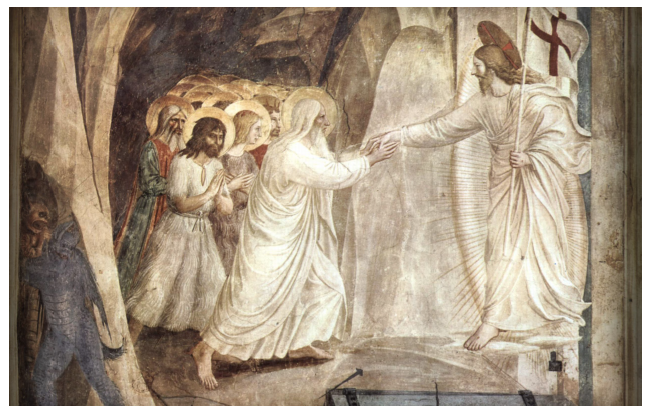
However, a change occurs with Augustine of Hippo. Augustine finds it unacceptable to
think that, prior to the advent of Christ, angels would carry the patriarchs into “Hell,”
as stated in Christ’s parable about the Rich Man and Lazarus — here reading Hades as
Hell. Hence, Augustine distinguishes “Abraham’s bosom” from “Hell,” suggesting that
the former was really a lesser paradise. This, of course, raises the question for Augustine
of whether Christ descends into both Hell and Abraham’s bosom, a question previous
authors did not ask because these were not seen as two different “places.” Augustine
affirms that Christ certainly descended to Abraham’s bosom, but he hesitates to say
that he descended into Hell. Augustine ultimately entertains the idea that Christ also
descends to Hell in order to liberate some who, by God’s mysterious justice (by which
he means predestination), he chose to liberate. But unlike the Eastern Church fathers,
who suggest that Christ liberates all, Augustine rejects such a view as absurd. Those that
did not believe on earth cannot find faith in Hell, says Augustine. As for the Eastern
view that Christ’s descent is a cosmic event for all peoples of all times, we see a stark
contrast in Augustine. He sees Christ’s descent as a one-time event that is relevant to
only those in Abraham’s bosom and those in Hell at the time of this descent; it has no
significance beyond this single moment in time. According to Augustine, the memory
of Christ’s descent was in fact obliterated after his departure. Hence, it has no lasting
effect for those who remained in Hell nor for those who descend there after Christ’s
ascent in the Resurrection.
Augustine’s views took on further weight when echoed by Gregory the Great. Like
Augustine, Gregory takes the declaration that Christ conquered Hell as hyperbolic,
rejecting the idea that he liberated all. Echoing Augustine, Gregory insists that one
cannot find faith in Hell if one has not believed when upon earth. As for who Christ
liberated, Gregory’s answer is the same as Augustine. He brought life to the righteous
in Abraham’s bosom, and if he liberated any from Hell, he did so only in keeping with
his mysterious election.
The doctrines of Augustine and Gregory were further codified in the West by the
council of Toledo in 625 AD. In the years to follow, conflict emerged between Pope
Boniface and an Irish missionary, Clement, over these Western revisions to the
doctrine. Clement insisted, in keeping with the East, that Christ did indeed liberate all
of humanity, regardless of whether these souls were believers or unbelievers when upon
the earth. Boniface convened a synod in Rome to condemn this view and reiterate the
view of Toledo — also held by Augustine and Gregory — that Christ liberated only the
OT righteous.
In the medieval period, the Western doctrine continued to develop in idiosyncratic
ways. Augustine’s distinction between Abraham’s bosom and Hell had already
introduced the notion of three spiritual regions: Heaven, Hell, and the lesser Heaven of
Abraham’s bosom. The medievals came to refer to Abraham’s bosom as a limbo, or
middle place, between Heaven and Hell. Hence it became known as the “limbo of the
fathers” (limbus patrum). But there emerged a second limbo in Western medieval
thought. Later medievals were less inclined than Augustine to grant the damnation of
unbaptized infants. Hence, there emerged the doctrine of a “limbo of infants” (limbus
infantium). The rationale for differentiating this limbo from the limbo of the fathers was
that the fathers believed and attained righteousness, while unbaptized infants simply
lack personal sins that merit damnation. While unbaptized infants are rightly kept from
the lowest Hell, they should not be elevated to the limbo of the fathers.
In addition, the medievals took further steps in developing the doctrine of Purgatory than previous writers. While earlier fathers spoke of post-mortem purgation of souls,
the medieval doctrine of Purgatory developed the doctrine into a formal “place” and
thus a further region of Hell48. In Purgatory, believers who fall short of beatitude
undergo penal suffering in order to purge the soul and deliver them to Paradise.
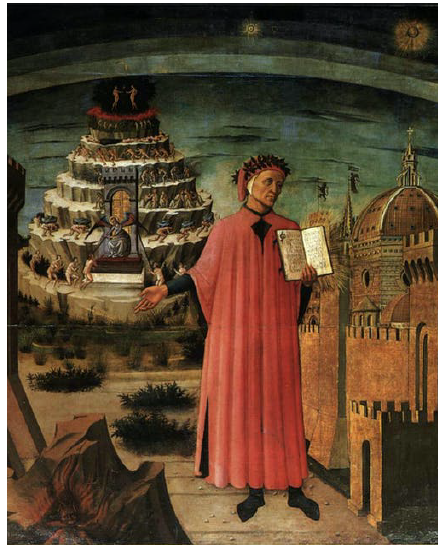
By the time of Thomas Aquinas, then, we find a doctrine of not only Paradise and
Hell, but of four regions of Hell. The lowest region is that of the damned. Above this
we find the other Hells. There is the Hell of infant limbo, where the souls of
unbaptized infants can never attain beatitude because they cannot attain baptism postmortem.
Yet, their pangs are less than those of the lowest Hell. In addition, there is the
Hell of the patriarchs (i.e., Abraham’s bosom), where the OT righteous awaited
liberation. There is also the Hell of purgatory, where believers who have received
baptism but still fall short of
beatitude, due to personal sins,
undergo suffering in preparation for
glory. Looking at Christ’s descent in
light of these developments,
Aquinas suggests that Christ
descended to either all the Hells or
into only the part where the
righteous were imprisoned. If the
former is true, Christ’s descent to
the lowest Hell would not be to
liberate the wicked, but to bring
shame to them for their unbelief. As
for the limbo of infants, this too
would not liberate, since only
baptism can cleanse original sin.
Liberation can only be offered to
the righteous who are already
prepared for everlasting glory49.
Such doctrines continued to inform the Roman Catholic teachings on Christ’s descent
for centuries to come. Such doctrines inform the romantic portrayals of the afterlife in
Dante’s Divine Comedy.
As should be clear from the foregoing, the differences between the East and the West on the doctrines of Hell and Hades are considerable. The East distinguishes Hell and Hades, while the West does not. The East teaches that Christ descended into Hades,
not Hell, while the West teaches that Christ’s descent is into Hell. The East teaches
that Christ’s descent was a cosmic event for all peoples of all times. The West teaches
that Christ’s descent was a one-time event. The East teaches that Christ’s descent
destroyed the power of Hades and liberated all of humanity from death — regardless of
whether all or only some choose to embrace this life. The West teaches that there are
numerous regions of Hell, and Christ liberated only those in one of these, while he left
bound those in the lower Hells of damnation and infant limbo. The East teaches that
Hades is forever transformed and defeated by this descent, the way back to God being
forever reopened. The West teaches that the memory of this one-time event was erased
from those left, as it had no bearing on their fate. The East sees in the various pictures
of Hades and Hell allegorical pictures of spiritual realities; the West sees a literal
depiction of various regions to which souls are bound post-mortem. Perhaps most
important, the East sees in Christ’s descent a critical feature of the gospel of his
liberation of humanity from death, while the West sees a one-time event that has no
significance beyond the Saturday on which it occurred.
1Josephus, Dissertation on Hades, passim.
2Chrysostom, Hom. Jn. 25.3 (PG 8.147c); Clement, exc. Theod. 38 (PG 9.677b).
3Andreas of Caesarea, Apoc. 59 (PG 106.408b).
4Philo of Alexandria, De congressu eruditionis gratia, 57.
5Origen, Hom. Jer. (PG 13.445, 448); Chrysostom, Hom. LXXVI; St. Symeon the New Theologian, Disc. 78.
6The association of divinity and fire was both a biblical one (e.g., Heb 12:29) and a philosophical one, reflected in the philosophy of Heraclitus and the Stoics, for example.
7Basil, Hom. Ps. 28.
8Cf. Origen, Cels. 5.16 (PG 11.1205a).
9Maximus the Confessor, Ad Thal. 59 (PG 90.609c); cf. John of Damascus, Exp. Ortho. fide 3.29 (PG 94.1101a).
10The Second Part, XXXIX, 22.
11Gregory of Nyssa, De vita Moysis, 2.82.
12Hom. Matt 36.3 (PG 7.411a).
13Chrysostom, Hom. Rom. 16.
14Irenaeus,Haer. 5.31.2 (PG 7.1209b); Athansius, Or. iii adv. Ar., 1.43 (PG 26.101b);Theodoret of Cyrus, Eranisles, 3 (PG 4.199); Basil of Caesarea, Hom. Ps. 48 (PG 29.453a); Macarius of Egypt, Hom. 11.19 (PG 34.552c); Cyril of Alexandria, Nest. 5.5 (PG 61.136d).
15Ignatius, Ep. Phil. 3, 9.
16Origen, 2nd Hom. Kings (PG 12.1021c); Chrysostom, Hom. 11 (PG 13.247a).
17Gregory of Nazianzus, Or. 43.75 (PG 36.597a); Origen, 2nd Hom. Kings (PG 12.1024a); Comm. Lk. 4.
18Origen, Hom.Gen. 15.5; engirt. 6 (PG 12.1020d); Cyril of Jerusalem, Cat. 14.17, 19.
19Cyril of Jerusalem, Cat. 19.4; Gregory of Nyssa, Apoll. 17 (PG 45.1156a).
20Chrysostom, Hom. cem. cr. (PG 49.394-5); John of Damascus, Exp. Ortho. fide 3.29 (PG 94.1101a).
21Chrysostom, Hom. cem. cr. (PG 49.394-5).
22Justin, dial. 91.4 PG 6.693b; Athanasius, Term. Fid. 13 (PG 26.1269c); Cyril of Alexandria, Jo. 4.2 (PG 73.353c).
23Cf. Chrysostom, Hom. Matt. 2.1.
24Gregory of Nyssa, Orat. cat. 23-4.
25Origen, Comm. Rom. 5.10 (PG 14.1051c-2b); Chrysostom, Hom. cem. cr. (PG 49.395-6).
26Amphilochius of Iconium, Hom. 6.
27Eusebius, CH, 1.13.20; Gregory of Nazianzus, Disc. 45.1-2 (PG 36.624c); Chrysostom, Hom. cem. cross (PG 49.394-5); Epiphanius of Cyprus, Exp. fide 17 (PG 42.814c-6a).
28Origin, Comm. Jn. 6; Basil of Caesarea, Hom. Ps. 48.9 (PG 29.451-4); Pseudo-Macarius, Spiritual Hom. 11.11-3 (PG 34.552d-6a).
29Athanasius, Contra Arii. 3.56 (PG 26.441a); Amphilochius of Iconium, Hom. 6; Chrysostom, Hom. cem. cr. (PG 49.395-6); Cyril of Alexandria, 7th Pasch. Hom. (PG 77.552a);
Gregory of Naz., Disc. 45.24 (PG 36.657a).
30Melito, De bapt. frag. 8b, 4.
31Clement of Alexandria, Stro. 6.6; Origen, Contra Celsus 2.43; Maximus the Confessor, Ad Thal. 7 (PG 90.284b-c); John of Damascus, Exp. Ortho. fide 3.29 (PG 94.1101a).
32Irenaeus, Against Heresies, 4.27.2.
33Clement of Alexandria, Stro. 6.6; John of Damascus, Exp. Ortho. fide 3.29 (PG 94.1101a); Maximus the Confessor, Ad Thal. 7 (PG 90.284b-c).
34See Nathan A. Jacobs, “On Whether the Soul is Immortal according to the Eastern Church Fathers,” St. Vladimir’s Quarterly, section 4.
35Maximus the Confessor, Ad Thal. 7 (PG 90.284b-c).
36PG 59.721-24.
37Methodius, Res. 2.18 (PG 18.284a).
38Chrysostom, Hom. 1 Cor. 24.7 (PG 12.142-3).
39Origen, Comm. Rom. 5.10 (PG 14.1051c-2b).
40John of Damascus, Exp. Ortho. fide 3.29 (PG 94.1101a).
41Eusebius,CH, 1.13.20; Basil, Hom. Ps. 48.9(PG 29.451-4).
42Gregory of Nyssa, De anima (v.444).
43De anima (v.833-5); Ep. Bishop Theod.
44Chrysostom, Hom. cem. cr.(PG 49.394-5).
45Chrysostom, Hom. cem. cr. (PG 49.394-5).
46Pseudo-Macarius, Spiritual Hom. 11.11-3 (PG 34.552d-6a).
47Cyril of Alexandria, 7Festive Letters, 2.8; 5.1; 6.12; 11.8; 14.2; 20.4 (PG 77.848-9); 21.3 (PG 77.856a); 28.4 (PG 77.956a).
48The Eastern fathers often presume that further purification of the soul may be needed post-mortem, before the soul can rest in God (e.g., Basil, Hom. Ps. 7.2). But such a view should not be confused with the Western doctrine of Purgatory. Rather, it is merely a presumption that
restoration of the human person — body and soul — that Christ came into the world to affect is a
lifelong process, and it is not complete until the resurrection from the dead, when the body and the
soul are both restored and partake of divine immortality (see Jacobs, “On Whether the Soul is
Immortal,” section 4). The point is especially evident because the Western councils of Florence and
the Second Council of Lyons both intentionally avoided talk of place and of fire when discussing
Purgatory, knowing that the Eastern Churches would disapprove. Moreover, the Eastern
opposition to this Western doctrine is pervasive in the anti-Western polemics of Mark of Ephesus.
49One might rightly wonder in the light of this doctrine why the patriarchs of old, whowere not baptized, and thus were not delivered from the stain of original sin — baptism being the Augustinian/Western means of cleansing original sin — were able to be rescued by Christ but
infants were not.
This article is copyrighted by and published with the permission of the original author Nathan A. Jacobs, Ph.D.
